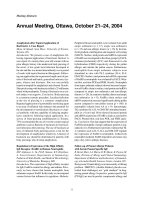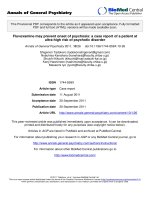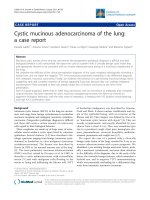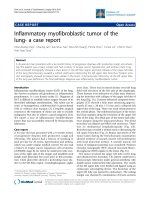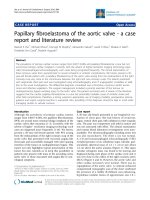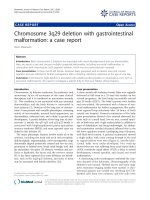Báo cáo y học: " Locally relapsed and metastatic uterine leiomyoma: A case report" doc
Bạn đang xem bản rút gọn của tài liệu. Xem và tải ngay bản đầy đủ của tài liệu tại đây (1.79 MB, 6 trang )
BioMed Central
Page 1 of 6
(page number not for citation purposes)
Journal of Medical Case Reports
Open Access
Case report
Locally relapsed and metastatic uterine leiomyoma: A case report
Ambrogio P Londero*
1
, Patrizia Perego
2
, Costantino Mangioni
3
,
Ralph J Lellé
4
, Franco Londero
5
and Diego Marchesoni
1
Address:
1
Clinica di Ginecologia ed Ostetricia, University of Udine, piazzale SM della Misericordia, Udine, Italy,
2
Istituto di Anatomia Patologica,
University of Milano Bicocca, Milan, Italy,
3
Clinica di Ginecologia ed Ostetricia, University of Milano, via Mayr, Milan, Italy,
4
Klinik und Poliklinik
für Frauenheilkunde und Geburtshilfe, Albert-Schweitzer-Straße, Münster, Germany and
5
UO Ostetricia e Ginecologia – San Polo, via Galvani,
Monfalcone, Italy
Email: Ambrogio P Londero* - ; Patrizia Perego - ;
Costantino Mangioni - ; Ralph J Lellé - ; Franco Londero - ;
Diego Marchesoni -
* Corresponding author
Abstract
Introduction: Benign metastasising leiomyoma refers to a type of lesion characterised by
leiomyomatous alterations without any indication of malignancy. It presents as either a singular
nodule or multiple nodules of proliferating smooth muscle cells and is generally found in the lungs
of women who have undergone a hysterectomy. The purpose of this case report is to contribute
to the knowledge of this rare disease by presenting evidence and experience of a patient case. In
particular, this report seeks to investigate the therapeutic approaches in order to understand
whether a standard of care can be prescribed and whether the use of prophylaxis therapy with
progesterone as a follow-up to surgery serves as a reasonable treatment in certain cases diagnosed
as benign metastasising leiomyoma.
Case presentation: We present the case of a 52-year-old Caucasian woman who developed a
pelvic relapse and a pulmonary localisation of benign metastasising leiomyoma following a
hysterectomy for myomatous uterus.
Conclusion: Our literature review revealed a single case of the use of chemoprophylaxis as
treatment of a benign metastasising leiomyoma. The role of chemoprophylaxis in preventing future
recurrences remains unclear. The use of progesterone as an adjuvant therapy for benign
metastasising leiomyoma could simply be palliative, with associated psychological benefits, or it
could be of therapeutic significance.
Introduction
There are conditions, although rare, in which histologi-
cally apparently benign leiomyomas of corpus uteri
extend beyond their usual boundaries or are associated
with extra-uterine leiomyomas. The term benign metasta-
sising leiomyoma (BML) refers to a type of lesion charac-
terised by leiomyomatous alterations without any
indication of malignancy. It presents as single or multiple
nodules of proliferating smooth muscle cells, usually in
the lungs of women who have undergone a hysterectomy.
Controversy exists as to whether lung leiomyomas repre-
sent the synchronous or metachronous development of
an independent lung lesion; the term more readily
Published: 23 September 2008
Journal of Medical Case Reports 2008, 2:308 doi:10.1186/1752-1947-2-308
Received: 7 November 2007
Accepted: 23 September 2008
This article is available from: />© 2008 Londero et al; licensee BioMed Central Ltd.
This is an Open Access article distributed under the terms of the Creative Commons Attribution License ( />),
which permits unrestricted use, distribution, and reproduction in any medium, provided the original work is properly cited.
Journal of Medical Case Reports 2008, 2:308 />Page 2 of 6
(page number not for citation purposes)
describes the metastases of a benign uterine primary
tumour, and certainly recent molecular investigators tend
to favour this latter definition [1].
The purpose of this report is to contribute to the knowl-
edge of this rare disease by presenting evidence and our
experience of a patient case. In particular, this case report
seeks to investigate the therapeutic approaches in order to
understand whether a standard of care can be prescribed
and whether the use of prophylaxis therapy as a follow-up
to surgery serves as a reasonable treatment in certain cases
diagnosed as BML.
Case presentation
A 52-year-old Caucasian woman, gravida IV, para 2, abor-
tus 2, with a 5-year history of uterine leiomyomas, pre-
sented in January 1999 with a pelvic mass of 87 mm at its
greatest diameter at sonography. In July 2000, the mass
had increased in volume, and in January 2001, the patient
was admitted to hospital for a total abdominal hysterec-
tomy with a bilateral salpingo-oophorectomy owing to
uterine leiomyomas.
At laparotomy, the uterus was found to be three times the
normal size (14 cm × 14.5 cm). In addition, a mass of
about 30 mm in diameter located in the right laterocervi-
cal region was resected; this second mass was softer and
less resistant to indentation than the leiomyomas inside
the uterus. The ovaries appeared to be regular. The histo-
logical exam confirmed the presence of multiple leiomyo-
mas of the corpus uteri and a right laterocervical
leiomyoma. All of the specimens considered were positive
for oestrogen and progesterone receptors. At 2-month fol-
low-up, there was no evidence of disease. More than 10
years before admission, two incomplete abortions had
occurred in the first trimester of pregnancy and had been
followed by uterine curettages.
After 3 years, the patient presented with abdominal bloat-
ing and occasional abdominal pain. A pelvic sonographic
examination revealed a mass of 12 cm at its greatest point.
In December 2004, magnetic resonance imaging was car-
ried out. This revealed the pelvic mass to be solid and
non-homogeneous, as evidenced by the presence of
haemorrhagic areas, necrosis and vascular structures; the
non-homogeneous nature was reinforced following the
injection of contrast medium whereby non-homogeneous
high enhancement became apparent. The mass was con-
nected to the right pelvic wall via a vascular supply that
appeared to originate from the iliac vessels in the obtura-
tor region. The rectum and bladder walls did not appear
to be affected by the growth of the mass. A positron emis-
sion tomography-computed tomography (PET-CT) total
body scan was performed, from which a pelvic localisa-
tion with low glucose affinity could be concluded. There
were no pulmonary masses on pre-operative chest X-ray.
In order to remove the mass, a second abdominal inter-
vention was performed, which revealed no evidence of
tumour invasion in the pelvis or abdominal viscera. The
mass measured 13 cm × 9 cm × 6 cm, was delimited by
serosa, and when cut appeared to be myxoid and with
oedematous areas inside.
Histologically, spindle-shaped smooth muscle cells were
present each containing a regular oval nucleus, without
mitosis and with a moderate vascularisation and oedema-
tous aspect. The cells were positive for smooth muscle spe-
cific actin, and there was a low proliferation index (2% of
nucleus being MIB-1 positive). Again, the specimens
expressed oestrogen and progesterone receptors (Figures 1
to 3). The final diagnosis was leiomyoma.
In light of the histological results and the lack of evidence
to suggest immediate prescription of radiotherapy or
chemotherapy, the decision was taken to withhold treat-
ment and await observation at follow-up.
A routine chest X-ray the following year, in May 2005,
showed a nodular posterior basal density in the right lung
of about 4 cm in diameter. The presence of a single nodu-
lar mass was confirmed at CT scan of the thorax (Figure 4).
At this point, a second PET-CT total body scan was per-
formed, showing a pulmonary lesion with a low meta-
bolic gradient, as is consistent with a benign lesion.
In June 2005, a right lower lung lobectomy was per-
formed, during the course of which an intra-operative fro-
zen section was also carried out. This failed to identify any
malignant elements. A subsequent and more accurate his-
tological examination permitted identification of the
mass as a mesenchymal neoplasm with a smooth muscle
differentiation, typifying a leiomyoma. Evidence to this
effect was as follows: a low mitotic index of less than 1
mitosis per 10 high-power fields (HPFs); a low MIB-1
index of 1%; and a positive immunohistochemistry reac-
tion for oestrogen receptors, progesterone receptors, H-
caldesmon and desmins. Moreover, testing was negative
for keratins, Bcl2, CD10 and CD99.
A review of the histological pattern of the original mass
and pulmonary mass showed low mitotic indices in both
the pelvic mass (2 mitoses per 10 HPFs) and also the pul-
monary mass (less than 1 mitosis per 10 HPFs) and that
the histology of the masses was similar, typifying a leio-
myoma (Figures 1, 3 and 5).
One month after the intervention, a course of chemother-
apy prophylaxis was commenced using 80 mg per day of
Journal of Medical Case Reports 2008, 2:308 />Page 3 of 6
(page number not for citation purposes)
megestrol. At the 6-month follow-up, a CT scan of the tho-
rax and abdomen was negative for masses; the 12-month
examination was similarly negative.
Discussion
In our literature review, we could only find around 100
documented cases that make reference to BML diagnoses
[2]. Even if this is an under-diagnosed condition owing to
the lack of symptoms, it is still a rare disease. The nodules
in the lungs are usually detected post-hysterectomy, with
detection ranging from some months up to decades.
In explaining the histogenesis of these lesions, opinion in
the existing literature can be classified into three main
streams. For proponents of the first approach, the uterine
neoplasm is regarded as a low-grade leiomyosarcoma
with malignant potential. The second approach centres on
the presence of lung emboli formed of cells that origi-
nated from a benign leiomyoma of the uterus. The third
(A), (B) Histological appearance of primary uterine leiomyomaFigure 1
(A), (B) Histological appearance of primary uterine leiomyoma. (C), (D) Pelvic relapsed leiomyoma. (E), (F) Pulmo-
nary mass (haematoxylin and eosin staining; (A), (C), (E) magnification ×10; (B), (D), (F) magnification ×40).
(A) Area with oedematous aspectFigure 2
(A) Area with oedematous aspect. (B) Normal spindle-shaped smooth muscle cells and area of ischaemic necrosis with
haemosiderin deposition. (C) Haemorrhagic area inside the mass (haematoxylin and eosin staining; magnification ×10).
Journal of Medical Case Reports 2008, 2:308 />Page 4 of 6
(page number not for citation purposes)
and final hypothesis asserts that multi-focal smooth mus-
cle proliferations may be the result of the independent
growth of smooth muscle tissue in response to hormonal
milieu.
Serving to validate the hypothesis that staminal mesen-
chymal cells from the myometrium are embolised to
other organs (lung, lymph nodes), our patient, in com-
mon with many other documented cases, had a previous
history of gynaecological surgery, including curettages
and hysterectomy.
Lesions are discovered incidentally, although symptoms
such as coughing, chest pain and dyspnoea have been
noted. Furthermore, lesions produce differing outcomes,
some of which lead ultimately to fatality.
The differential diagnosis for pulmonary nodules on chest
radiography includes benign and malignant primary and
metastatic neoplasms, vascular lesions, infectious and
noninfectious inflammatory granuloma and collagen vas-
cular disease. In every instance when a locally relapsed
disease with a distant metastasis is discovered, all of the
observed possibilities must be considered. One important
step that brings us to diagnosis involves performing either
a biopsy or a surgical resection.
Pulmonary specimens for histological analysis have been
obtained through various methods, including percutane-
ous biopsy, transbronchial lung biopsy and lobectomy.
The greatest challenge in distinguishing a leiomyoma
from a leiomyosarcoma concerns assigning the intermedi-
ate combination of diagnostic criteria, in order to decide
whether the patient is experiencing a benign or malignant
disease.
When mesenchymal cell neoplasms are present, the histo-
logical differential diagnosis falls between BML, primary
pulmonary leiomyoma, leiomyosarcoma, metastatic BML
from a source other than female genital internal organs,
hamartoma and lymphangioleiomyomatosis.
The first therapy proffered in the literature relates to the
surgical resection of the pelvic recurrence and, where pos-
sible, the pulmonary localisations. Several authors noted
a more favourable outcome after bilateral oophorectomy,
including a curative aspect of this surgical intervention
[3]. However, in some documented cases, as in ours, bilat-
eral oophorectomy has no influence on the growing leio-
myoma mass. Surgery aside, there is considerable
discussion in the literature regarding drug treatment ther-
apy for BML. In certain instances, the luteinising hor-
mone-releasing hormone analogue (goserelin) had a
therapeutic role where other hormonal therapies
(A) Immunohistochemical staining for oestrogen receptors of the pelvic relapsed massFigure 3
(A) Immunohistochemical staining for oestrogen
receptors of the pelvic relapsed mass. (B) Immunohis-
tochemical staining for oestrogen receptors of the pulmo-
nary mass. (C) Immunohistochemical staining for
progesterone receptors of the pelvic relapsed mass. (D)
Immunohistochemical staining for progesterone receptors of
the pulmonary mass (magnification ×40).
Computed tomography scan of the thorax showing single nodular mass in the right lung of about 4 cm in diameter, evi-dent 1 year after the pelvic recurrence resectionFigure 4
Computed tomography scan of the thorax showing
single nodular mass in the right lung of about 4 cm in
diameter, evident 1 year after the pelvic recurrence
resection.
Journal of Medical Case Reports 2008, 2:308 />Page 5 of 6
(page number not for citation purposes)
(medroxyprogesterone, tamoxifen) had failed to achieve
the curative targets [4].
Tamoxifen has proven to be effective in vitro for decreasing
cell numbers and for stopping cell proliferation [5], but its
role remains uncertain in vivo [6]. Another selective oes-
trogen receptor modulator, raloxifene, was documented
as a successful BML treatment when administered in asso-
ciation with an aromatase inhibitor [7]. Aromatase inhib-
itors represent a further drug category possessing the
ability to reduce the volume of a leiomyoma [7]. Proges-
terone has proven to be effective in the treatment of BML
metastasised to the lungs, and there are examples of a
complete resolution after the administration of megestrol
[2].
The utilisation of long-acting GnRH analogues, which
suppress pituitary gonadotrophin biosynthesis by
decreasing the number and sensitivity of GnRH receptors,
has been documented with favourable results in several
reports [8]. The literature documents the regression of
metastatic lesions in certain instances. This can be attrib-
uted to the significant drop in oestrogen levels that occurs
after the end of pregnancy [9] and after the surgical or
physiological menopause [3].
A number of different classes of growth factors and apop-
tosis-related factors have been identified as having a high
likelihood of affecting leiomyoma growth, vascularity and
extracellular matrix deposition: epidermal growth factor,
insulin-like growth factors, transforming growth factor-β
family, platelet-derived growth factor, angiogenic factors,
Bcl-2 protein, tumour necrosis factor-α and p53 protein.
The heterogeneity of leiomyoma growth within the same
uterus, despite the identical exposure to circulating sex
steroid concentrations, suggests the involvement of local
growth factors. These are expressed differently in normal
smooth muscle and leiomyoma, which indicates that such
factors may be involved in paracrine stimulation [10].
These results indicate that future non-surgical treatments
for leiomyomas may include compounds that block the
actions of specific growth factors involved in the control
of uterine smooth muscle cell proliferation and growth.
The complexity of the interactions existing between spe-
cific growth factors, hormonal composition and leiomy-
oma behaviour and development forms the basis for
understanding how a certain therapy can achieve a posi-
tive outcome in one instance, and yet fail to take effect in
others. In order to make an informed decision as to which
treatment to administer, an improved characterisation of
the molecular expression and genetics of leiomyoma is
necessary. Such information will likely clarify the reasons
why certain therapies appear more efficacious with spe-
cific types of leiomyoma [11]. Future research should fur-
ther seek to identify markers of prognosis that are
informative about the risk of developing a BML. Our evi-
dence and experiences presented in this report tend to
suggest that BML, rather than being a homogeneous clas-
sification, should be viewed as a more general term
encompassing an inclusive range of leiomyoma display-
ing unique characteristics and thus following separate
growth patterns. It is for precisely this reason that different
outcomes are observed when a particular treatment is
administered in separate cases.
A review of BML therapies was carried out with the inten-
tion of clarifying the rationale for the use of a drug proph-
ylaxis to prevent recurrences. Following an analysis of the
existing literature, it was ascertained that the use of pro-
gesterone (medroxyprogesteron) as a prophylactic agent
was limited to a single documented case [12].
(A) Histological appearance of the pulmonary mass with an area of fibrosis and an area that represents pulmonary tissueFigure 5
(A) Histological appearance of the pulmonary mass with an area of fibrosis and an area that represents pulmo-
nary tissue. (B) Immunohistochemical staining of the pulmonary mass for desmin. (C) Immunohistochemical staining of the
pulmonary mass for Ki-67.
Publish with BioMed Central and every
scientist can read your work free of charge
"BioMed Central will be the most significant development for
disseminating the results of biomedical research in our lifetime."
Sir Paul Nurse, Cancer Research UK
Your research papers will be:
available free of charge to the entire biomedical community
peer reviewed and published immediately upon acceptance
cited in PubMed and archived on PubMed Central
yours — you keep the copyright
Submit your manuscript here:
/>BioMedcentral
Journal of Medical Case Reports 2008, 2:308 />Page 6 of 6
(page number not for citation purposes)
Conclusion
In our patient, following two recurrences and consequent
surgical resections within a short period, the decision was
taken to use a chemoprophylaxis agent despite the uncer-
tainty surrounding its role in preventing future recur-
rences [12]. As a concluding point, progesterone used as
adjuvant therapy for BML could simply be palliative, with
the associated psychological benefits, or it could be of
therapeutic significance. Our conclusions are, however,
limited owing to the scarcity of pathological cases investi-
gating this theme.
Abbreviations
BML: benign metastasising leiomyoma; CT: computed
tomography; HPF: high-power field; MRI: magnetic reso-
nance imaging; PET-CT: positron emission tomography-
computed tomography.
Competing interests
The authors declare that they have no competing interests.
Authors' contributions
APL, RJL and DM carried out the literature research and
drafted the manuscript. PP made pathology contribu-
tions. CM and FL carried out the clinical and surgical man-
agement and helped in drafting and the critical revision of
the manuscript.
Consent
Written informed consent was obtained from the patient
for publication of this case report and any accompanying
images. A copy of the written consent is available for
review by the Editor-in-Chief of this journal.
Acknowledgements
We are grateful to Eilidh PJ McIntosh for her suggestions on the style and
grammatical correctness of our English. Dr Giovanni Falconieri and Dr
Alessandro Brollo are thanked for their helpful collaboration in providing
the images. We are also grateful to Dr Vito D'Aietti for his help and sup-
port.
References
1. Patton KT, Cheng L, Papavero V, Blum MG, Yeldandi AV, Adley BP,
Luan C, Diaz LK, Hui P, Yang XJ: Benign metastasizing leiomy-
oma: clonality, telomere length and clinicopathologic analy-
sis. Mod Pathol 2006, 19:130-140.
2. Abu-Rustum NR, Curtin JP, Burt M, Jones WB: Regression of uter-
ine low-grade smooth-muscle tumors metastatic to the lung
after oophorectomy. Obstet Gynecol 1997, 89:850-852.
3. Jacobson TZ, Rainey EJ, Turton CWG: Pulmonary benign metas-
tasizing leiomyoma: response to treatment with goserlin.
Thorax 1995, 50:1225-1226.
4. Burroughs KD, Kiguchi K, Howe SR, Fuchs-Young R, Trono D, Bar-
rett JC, Walker C: Regulation of apoptosis in uterine leiomyo-
mata. Endocrinology 1997, 138:3056-3064.
5. Liu IF, Yen YS, Cheng YM, Chou CY: Mitotically active leiomy-
oma of the uterus in postmenopausal breast cancer patient
receiving tamoxifen. Taiwan J Obstet Gynecol 2006, 45:167-169.
6. Rivera JS, Christopoulos S, Small D, Trifiro M: Hormonal manipu-
lation of benign metastasizing leiomyomas: report of two
cases and review of the literature. J Clin Endocrinol Metab 2004,
89:3183-3188.
7. Wentling GK, Sevin BU, Geiger XJ, Bridges MD: Benign metasta-
sizing leiomyoma responsive to megestrol: case report and
review of the literature. Int J Gynecol Cancer 2005, 15:1213-1217.
8. Nardo LG, Iyer L, Reginald PW: Benign pulmonary metastatisiz-
ing leiomyomatosis in pregnancy: a rare complication after
Cesarean section. Acta Obstet Gynecol Scand 2003, 82:770-772.
9. Horstmann JP, Pietra GG, Harman JA, Cole NG, Grinspan S: Spon-
taneous regression of pulmonary leiomyomas during preg-
nancy. Cancer 1977, 39:314-321.
10. Maruo T, Ohara N, Wang J, Matsuo H: Sex steroidal regulation of
uterine leiomyoma growth and apoptosis. Hum Reprod Update
2004, 10:207-220.
11. Stewart EA, Morton CC: The genetics of uterine leiomyomata.
Obstet Gynecol
2006, 107:917-921.
12. Pawlik C, Wildberger JE, Tietze L, Matern S, Busch N: Benign
metastasizing leiomyoma of the lung: a rare differential diag-
nosis of pulmonary space-occupying lesions. Dtsch Med
Wochenschr 2001, 126:551-555.
